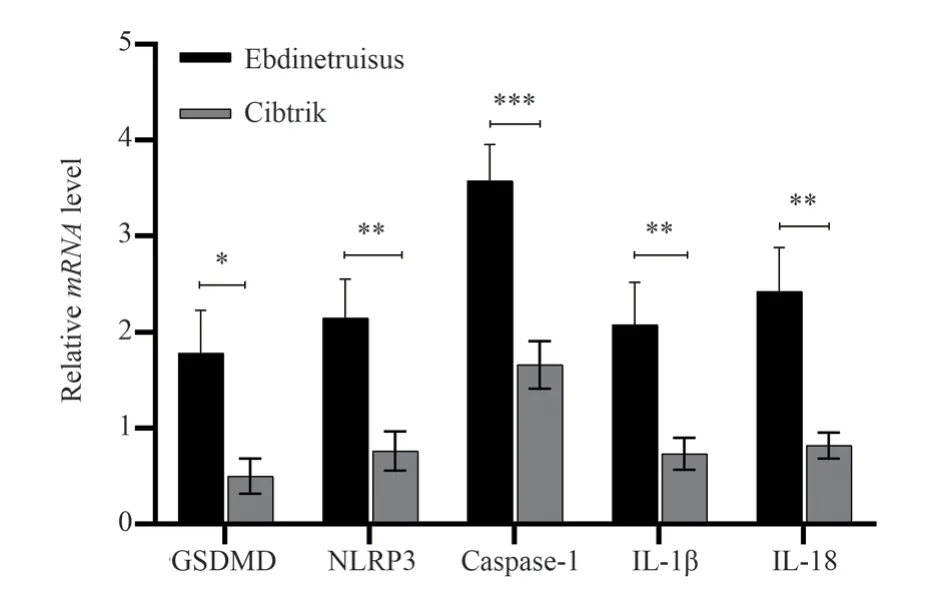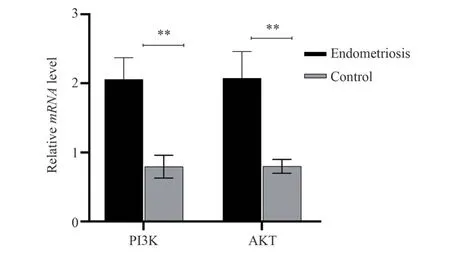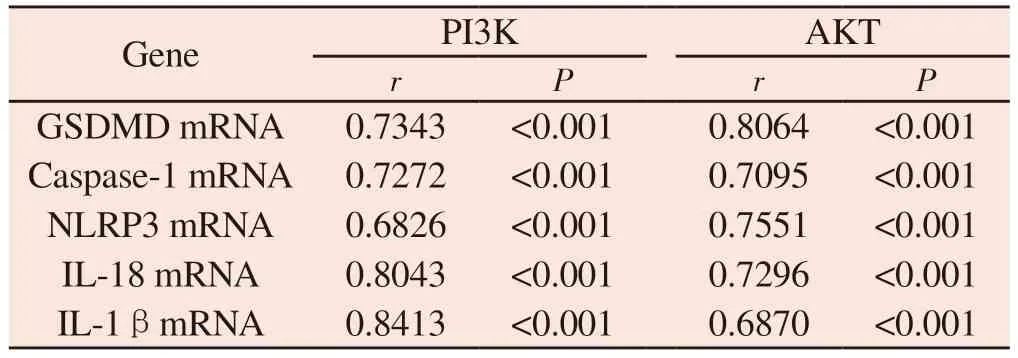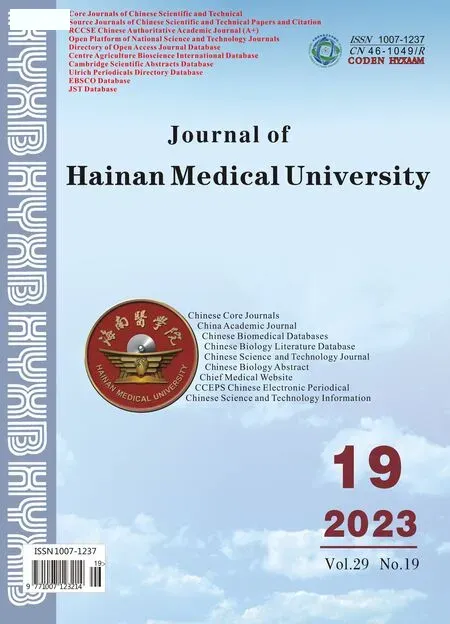Expression and correlation of pyroptosis-related markers and PI3K/AKT pathway in endometriosis
CHANG Yu-huan, LV Li-li, LI Man, WANG Meng-ge, ZHANG Ming-juan, YE Guo-liu
Department of Obstetrics and Gynecology, the First Affiliated Hospital of Bengbu Medical College, Bengbu 233004, China
Keywords:
ABSTRACT Objective: The expression of pyroptosis related factors GSDMD, Caspase-1, NLRP3, IL-1β,IL-18 and PI3K/AKT signaling pathways in ovarian endometriosis was investigated and their correlations analyzed.Methods: A total of 50 patients with endometriosis who underwent ovarian cystectomy in the Department of Gynecology, the First Affiliated Hospital of Bengbu Medical College from January 2022 to January 2023 were enrolled as endometriosis group.In addition, 55 patients with normal endometrial tissue who underwent hysteroscopic surgery in the hospital during the same period were selected as the control group, and patients with endometriosis were excluded during the operation.RT-qPCR, Western Blot was used to detect the expression of pyroptosis-related factor and PI3K/AKT signaling pathway mRAN, protein in the above tissues, and the correlation between the expression of the two was analyzed by Pearson correlation test.Results: The expression of pyroptosis-related factors and mRAN of PI3K/AKT signaling pathway in ectopic ovarian cyst tissues was significantly higher than that in the control group, and the difference was statistically significant (P < 0.05).Pearson correlation analysis showed that pyroptosis-related factors in ectopic ovarian cysts were positively correlated with the mRNA expression levels of PI3K/AKT signaling pathway (P< 0.05).Conclusion: The pyroptosis correlation factors GSDMD, Caspase-1, NLRP3, IL-1β, IL-18 and PI3K/AKT signaling pathways are highly expressed in ovarian endometriosis,and the pyroptosis-related factors are positively correlated with the expression of PI3K/AKT signaling pathway, suggesting that the regulation of endometriosis by activating the PI3K/AKT signaling pathway is likely to be achieved by activating the PI3K/AKT signaling pathway.
1.Introduction
Endometriosis (EMS) is a multifactorial gynecological disorder characterized by the growth of endometrial glands and stroma outside the uterine cavity, affecting nearly 10~15% of women of childbearing age, with a prevalence rate of approximately 40~50%among infertile patients[1].It is an estrogen-dependent disease closely associated with chronic inflammatory processes, chronic pelvic pain, dysmenorrhea, and infertility, which greatly reduces the quality of life of women of reproductive age[2].Endometriosis has many similarities with malignant tumors, in particular their invasive nature and ability to trigger remodeling, angiogenesis and innervation of other tissues[3].Inflammation is an important pathophysiological mechanism of endometriosis[4].Studies have reported that inflammatory response can increase the adhesion and proliferation characteristics of ectopic endometrial cells by promoting the release of inflammatory factors[5].Therefore, it is of great clinical significance to explore the pathogenesis and therapeutic targets of inflammation in this disease.
Pyroptosis is a kind of programmed cell death accompanied by inflammatory response[6], which has been the focus of inflammation research in recent years.Studies have found that the PI3K/AKT signaling pathway plays a key role in the occurrence of pyroptosis,and pyroptosis plays different roles in different inflammatory diseases[8,7].Based on the above research background, this study aims to investigate the expression and correlation of pyroptosisrelated factors GSDMD, Caspase-1, NLRP3, IL-1β, IL-18 and PI3K/AKT signaling pathway in the inflammatory disease endometriosis, so as to further explore the pathogenesis of endometriosis.It also provides specific targets and experimental basis for clinical treatment.
2.Materials and Methods
2.1 Collection of clinical specimens
From January 2022 to January 2023, 50 cases of ectopic cyst tissue from patients with endometriosis ovarian cyst removal in the Department of Gynecology of the First Affiliated Hospital of Bengbu Medical College were selected as the endometriosis group.In addition, 55 cases of normal endometrial tissue from patients who underwent hysteroscopic surgery in the hospital during the same period were selected as the control group, and patients with endometriosis were excluded during the operation.The age of the case group ranged from 20 to 41 years, with a mean age of (37.6± 5.7) years, and the age of the control group ranged from 21 to 43 years, with a mean age of (38.3 ± 7.8) years.There was no statistically significant difference between the ages of the study subjects in the two groups (P > 0.05) and they were comparable.Inclusion criteria: 1:no sex hormone drug treatment was given within 3 months; 2:All the specimens obtained during the operation were confirmed by pathological examination.3:The specimens were collected with the consent of patients and their families.Exclusion criteria: 1:Severe dysfunction of heart, liver, kidney and other serious gynecological diseases; 2:patients with malignant tumors and mental disorders; 3:patients with immune and endocrine system diseases.All tissue specimens taken during the operation were stored in a refrigerator at -80 ° C for research use.This study met the ethical standards for human experimentation and was approved by the Institutional Ethics Committee of the First Affiliated Hospital of Bengbu Medical College.
2.2 Experimental Methods
2.2.1 Total RNA extraction and real-time quantitative PCR
TRIzol reagent was used to extract total RNA from ovarian endometriosis cyst tissues and normal endometrial tissues of the control group.After washing with nuclease-free water, the purity and concentration of total RNA were detected by Nanodrop ND-1000 spectrophotometer.The cDNA template was synthesized according to the instructions of the reverse Transcription and realtime quantitative PCR kit (Nearshore, China), and the fluorescence quantitative PCR amplification reaction was performed.Reaction conditions were preheating at 95 ℃ for 1 min, denaturation at 95 ℃for 20 SEC and extension at 60 ℃for 1 min.The 2-△△CTmethod was used to calculate the relative expression levels of pyroptosis-related factors and PI3K/AKT signaling pathway mRNA in the two groups.Primer sequences for pyroptosis-related factors and PI3K/AKT pathway are shown in Table 1.
2.2.2 Western blotting
RIPA lysis buffer (Biyutian) was prepared, and 50 mg of ovarian endometriosis ectopic cyst tissue or normal endometrial tissue was loaded into a homogenization tube with 500ulRIPA lysate,homogenized, centrifuged at 12 000 × g for 20 min at 4 ℃.Equal amounts of denatured proteins were separated by SDS-PAGE and transferred to PVDF membranes and blocked with 5% skim milk for 2 h.The PVDF membrane was then combined with the primary antibody (polyclonal anti-GSDMD; Caspase-1; NLRP3,1:000 dilution) were incubated in a 4 ℃ refrigerator overnight.The membranes were washed three times with TBST, and the membranes (diluted 1:1 000) were allowed to room temperature for 2 hwith secondary antibody.The samples were washed three times and exposed according to the instructions of BeyoECL kit.The final results were quantified by image J software.
2.3 Statistical analysis
SPSS 25.0 was used for data processing and Graphpad Prism 9 software was used for drawing.Unpaired t test was used to analyze the difference of pyroptosis-related factors and PI3K/AKT signaling pathway in ovarian endometriosis with ectopic cyst and normal endometrium, and Pearson test was used to analyze the correlation between them in ovarian endometriosis.P< 0.05 difference was statistically significant.
3.Results
3.1 The mRNA levels of pyroptosis-related factors and PI3K/AKT signaling pathway were significantly increased in ovarian endometriosis
RT-qPCR was used to compare the expression of GSDMD, NLRP3,Caspase-1, IL-1β, IL-18 and PI3K/AKT signaling pathway in ovarian endometriosis ectopic cyst and normal endometrium.The results showed that the expression of pyroptosis-related factors and signaling pathway PI3K/AKT was significantly increased in ovarian endometriosis (P < 0.05) (Figure 1 and Figure 2).

Fig 1 mRNA expression of pyroptosis-related factors in ectopic cysts of ovarian endometriosis versus normal endometrium

Fig 2 mRNA expression of the signaling pathway PI3K/AKT in ovarian endometriosis versus normal endometrium
3.2 Protein levels of pyroptosis-related factors and PI3K/AKT signaling pathway were significantly increased in ovarian endometriosis
Proteins from ectopic cysts and normal endometrium of ovarian endometriosis were extracted simultaneously, and the protein expression levels of pyroptosis-related factors and PI3K/AKT signaling pathway were verified in Western Blot experiments in both groups.The results showed that the protein expression levels of focal death-related factors and signaling pathways were significantly higher (P < 0.05) in ovarian endometriosis (Figs.3 and 4).

Fig 4 Expression of the signaling pathway PI3K/AKT at the protein level in ectopic cysts of ovarian endometriosis compared with normal endometrium
3.3 Positive correlation between pyroptosis-related factors and PI3K/AKT expression in ovarian endometriosis
Pearson correlation test was used to analyze the correlation between the mRNA expression of pyroptosis-related factors and PI3K/AKT signaling pathway in ovarian endometriosis.The results showed that the expression levels of pyroptosis-related factors were positively correlated with PI3K/AKT signaling pathway in ovarian endometriosis (P < 0.05).(Table 2).

Tab 2 Correlation between pyroptosis-related factors and expression levels of signaling pathway PI3K/AKT in ovarian endometriosis cells
4.Discussion
Endometriosis (EMS) is a common chronic inflammatory disease, which is also known as “immortal cancer”.Its complex symptoms bring great physical and psychological pain to women of childbearing age.However, so far, there is no perfect method to treat EMS.The treatments that have been introduced include(i) pharmacotherapy, (ii) conservative surgical interventions with preservation of the uterus and ovaries or radical surgical interventions with removal of the uterus and ovaries, and (iii)expectant therapy[9].Drugs can only be used to treat patients with symptoms, while surgery will not only affect the reserve function of ovarian follicles, but also have a recurrence rate of up to 50%[10].The most plausible explanation for the formation of this disease is the retrograde menstrual hypothesis, in which fragments of endometriosis containing viable cells return through the fallopian tubes to the pelvis, implant in the peritoneum and abdominal organs,and produce persistent inflammation and adhesions.Although this theory is accepted, it cannot explain why 90% of women experience retrograde menstruation but only 10% develop EMS[11].Therefore,in order to solve the problem of endometriosis, we need to fully understand the potential molecular pathogenesis of endometriosis on the basis of physiology and pathology, and find new therapeutic targets.
Pyroptosis is a special programmed cell death accompanied by the production and release of inflammatory factors, which is different from apoptosis.It has been a research hotspot in recent years.The cellular pyroptosis signaling pathway consists of a classical pathway dependent on cystein-containing aspartate-specific protease-1(Caspase-1) and a non-classical pathway dependent on Caspase-4/5/11[12].In the classical pathway NOD-like receptor protein 3(NLRP3) interacts with the junction protein apoptosis-associated speck-like protein (ASC) and the effector protein Caspase-1 (pro-Caspase-1) to generate NLRP3 inflammatory vesicles, during which precursor Caspase-1 is activated Activated Caspase-1 not only promotes the maturation of interleukin (IL)-1β and IL-18 precursors to stimulate the inflammatory response, but also cleaves gasdermin D (GSDMD), exposing its N-terminal structure with pore-forming activity (GSDMD-N), which forms a pore in the cell membrane and releases a large amount of IL-1β, IL-18, IL-1β, IL-18 and IL-18.of IL-1β, IL-18 and other inflammatory substances causing an inflammatory cascade response[13].Studies have reported that the occurrence of pyroptosis is related to the classical PI3K/AKT signaling pathway, and in different diseases, pyroptosis and PI3K/AKT signaling pathway play different roles[15,14].The latest study shows that maltol blocks the formation of NLRP3 inflammasome by inhibiting the PI3K/AKT signaling pathway, which eventually leads to the reduction of IL-1β, IL-18 and other inflammatory factors, thereby inhibiting pyroptosis and reducing the inflammation in the intervertebral disc[14].However, another study showed that taxol could inhibit pyroptosis by upregulating PI3K/AKT signaling pathway in BV2 microglia to reduce neuroinflammation after spinal cord injury[8].Therefore, we wanted to examine the role of pyroptosis and PI3K/AKT signaling pathway in inflammatory disease associated endometriosis.
Recent studies have shown that E3 ubiquitin ligase TRIM24 can negatively regulate NLRP3/Caspase-1/IL-1β mediated pyroptosis and migration of ectopic human endometrial stromal cells[16].Meanwhile, Ying et al.showed that silencing long non-coding metastasis-associated lung adenocarcinoma transcript 1 (lnc-MALAT1) in primary endometrial stromal cells could improve NLRP3-mediated pyroptosis and IL-1β release, thereby alleviating TGF-β1-mediated fibrosis[17].Consistently, the expressions of pyroptosis-related factors GSDMD, Caspase-1, NLRP3, and inflammatory factors IL-1β and IL-18 in ovarian endometriosis cyst tissues were higher than those in normal endometrium, which confirmed that the inflammatory response of pyroptosis is involved in the occurrence and development of endometriosis.In addition to pyroptosis-related factors, we also examined the expression of PI3K/AKT signaling pathway, and the results showed that PI3K/AKT signaling pathway was also highly expressed in ovarian endometriosis cyst tissues compared with normal endometrial tissues.The involvement of PI3K/AKT signaling in the development of endometriosis has been demonstrated earlier in previous studies[18,19].Takeuchi et al.found in recent years that excessive activation of the primary follicle can cause decreased ovarian reserve associated with endometriosis, and this activation is mediated by the PI3KPTEN-AKT-Foxo3 pathway[20].However, no studies have focused on the relationship between pyroptosis and PI3K/AKT signaling pathway in endometriosis.In this study, Pearson test analysis was used to conclude that the mRNA expression levels of pyroptosisrelated factors in ovarian endometriosis cyst tissues were positively correlated with the mRNA expression levels of PI3K and AKT signaling pathways, respectively.On the basis of previous studies and combined with this study, we hypothesized that the regulation of endometriosis by pyroptosis was achieved through the activation of PI3K/AKT signaling pathway.
In summary, this study for the first time links pyroptosis with PI3K/AKT signaling pathway in endometriosis, which is expected to further reveal the molecular mechanism of endometriosis and provide new therapeutic targets for endometriosis.This study is mainly limited to the histological level, so the verification is not sufficient.In the future, we will explore the specific regulatory mechanism of classical/non-classical pyroptosis pathway and PI3K/AKT signaling pathway in endometriosis from multiple dimensions from animal and cell experiments.
Author’s contributions
CHANG Yu-huan: Topic of conception and experiment, writing article; LV Li-li, LI Man, WANG Meng-ge, ZHANG Ming-juan:Experimental data collation and analysis; YE Guo-liu: Thesis guidance and revision, financial support.
All the authors have no conflicts of interest and agreed to submit the manuscript for publication.
 Journal of Hainan Medical College2023年19期
Journal of Hainan Medical College2023年19期
- Journal of Hainan Medical College的其它文章
- Study on the in vitro anti ovarian cancer effect and mechanism of quinazoline derivative (N111)
- m6A modification promotes the proliferation and migration of cervical cancer and regulates the expression of PD-L1
- Meta-analysis of the efficacy of volar plate internal fixation versus closed reduction and external fixation in the treatment of adult distal radius fractures
- A review of the epidemic and clinical study on scrub typhus in China(2010-2020)
- MiR-15a-5p in neutrophil exosomes promotes macrophage apoptosis through targeted inhibition of BCL2L2
- Clinical efficacy of bushen huatan huoxue recipe in combination with acupuncture in treating patients suffering from polycystic ovary syndrome with insulin resistance
